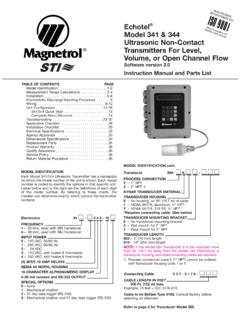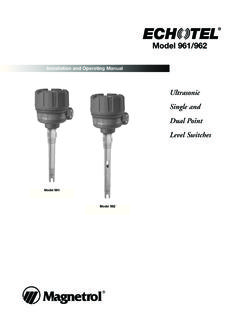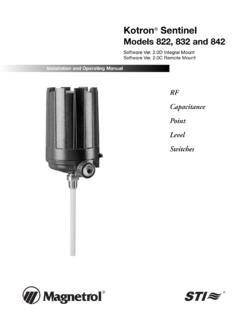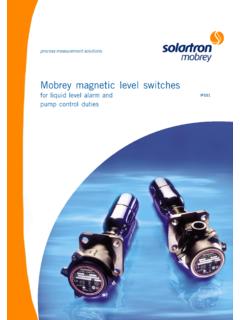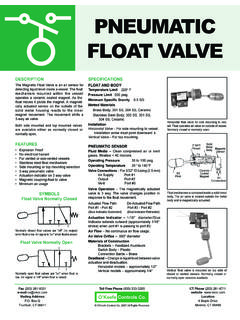Transcription of Selecting the Right Magnetic Indicator - …
1 A Guide ToJuly 2003 Selectingthe RightMagneticLevelIndicatorTable of ContentsMagnetic Level IndicatorsPREFACEI ntroduction .. the MLIO verview ..1 Principle of Operation ..1 MLI Mounting Styles ..2 Side Mount ..3 Top-In, Bottom-Out Level Measurement ..4 Advantages of the MLI ..5 Safety ..5 Maintenance ..6 Visibility ..6 Installation and Flexibility ..6 Selecting the Right MLI ..72 Indicator Types and of ..10 Selecting the Right Indicator ..11 Orion Indicators ..11 Indicator Sealing Methods ..12 Unsealed ..12 Sealed ..12 Valve-Sealed ..12 Selecting the Right Indicator Seal ..13 Orion Sealed Indicators ..133 Floats and ChambersFloat ..15 Selecting the Right Floats ..16 float the Right Chamber ..17 Orion Level Indicators4 MagnetsMagnets in an of Magnets ..21 Rare Earth.
2 21 Selecting the Right Magnet for an MLI .. Strength ..22 Magnetic Table ..22 Orion Magnets ..235 TransmittersMLI Transmitters ..25 Transmitter Types ..25 Reed Chain Transmitters ..26 Guided Wave Radar the Right Chain Transmitter ..27 Magnetostrictive Transmitter ..28 Guided Wave Radar Transmitter ..28 Orion Transmitters ..286 AccessoriesMagnetic Level Switches ..31 Selecting a Magnetic Switch ..31 Orion Switches ..31 Heat Tracing ..32 Selecting Heat Tracing ..32 Orion Heat Tracing ..32 Insulation Insulation Blankets ..33 Orion Insulation ..33 Frost Extension ..33 Magnetic Traps ..34 Gauge Glass ..347 Orion ..37 Gemini ..38iORI-300 Orion Magnetic Level Indicator Selection GuidePrefaceMagnetic Level IndicatorsIntroductionCompanies in the process industry need the ability to visually monitor liquidlevels in vessels (boilers, storage tanks, processing units, etc.)
3 Traditionally,armored glass sight gauges have been used. However, many companies want analternative to sight gauges to avoid problems such as breakage, leaks, or burstingat high pressures and extreme temperatures. In addition, the visibility of thesight glass can be poor and often affected by moisture, corrosion, or oxidation. Magnetic level indicators (MLIs) do not have the shortcomings of glass sightgauges and are suitable for a wide variety of installations. OrganizationThis handbook describes the configuration and operation of MLIs and providesinformation about their key components and features. Use this handbook as aresource when Selecting the Right MLI for a specific 1 Introducing the MLIP rovides an introduction to MLIs, describes the components, discusses theadvantages of an MLI over a glass sight gauge, and offers some general questionsto ask when Selecting an 2 Indicator Types and SealsDiscusses principles of operation, MLI shuttle and flag Indicator types, advan-tages and disadvantages of both Indicator types, and guidelines for Selecting anindicator for a specific 3 Floats and ChambersDiscusses the function of the MLI float and chamber, materials of constructionand properties, and guidelines for Selecting appropriate MLI floats 4 MagnetsProvides an overview of magnets including properties, advantages and disadvan-tages.
4 Discusses the functions of magnets in an MLI; and provides guidelines touse when appraising Orion Magnetic Level Indicator Selection GuideChapter 5 TransmittersDescribes the types of MLI transmitters available, presents an overview of theprinciples of operation for each type of transmitter, discusses the benefits andshortcomings of each, and provides guidelines for Selecting an 6 AccessoriesDiscusses typical accessories used with MLI devices and presents an overview ofthe operation of each 7 Orion MLIsDescribes the features of Magnetic level indicators engineered and manufacturedby Orion Instruments, presents information on various configurations of MLIs,discusses the benefits and limitations of each configuration, and provides guide-lines for Selecting the correct MLI configuration for a specific Level Indicators1 ORI-300 Orion Magnetic Level Indicator Selection GuideOverviewThe Magnetic level Indicator (MLI), also called a magneticallycoupled liquid level Indicator or amagnetic level gauge, is in wide-spread use throughout the processindustries.
5 Originally designed asan alternative to glass sight gauges,MLIs are now commonly usedin new construction andplant applications include: Alkylation units Boiler drums Feedwater heaters Industrial boilers Oil-water separators Process vessels Propane vessels Storage tanks Surge tanks Wastewater tanksPrinciple of OperationMagnetic level indicators use the principle of Magnetic field coupling to providefluid level information, to activate a switch, or to provide continuous level coupling allows an MLI to measure levels without direct contactbetween the Indicator and the fluid in the Magnetic field consists of the lines of flux surrounding a magnet. Thefield acts on other objects (magnets or ferromagnetic materials). When amagnetic field acts upon another object with sufficient force to move theobject, the magnet is said to be magnetically coupled with that object.
6 11 Introducing the MLIM agnetic Level Indicators2 ORI-300 Orion Magnetic Level Indicator Selection GuideIn an MLI, the magnets within a float and an indica-tor are magnetically float , located insidea chamber, tracks the surface of the liquid. A magnetor magnet assembly inside the float creates a magnet-ic field, which penetrates the chamber wall to couplewith the Magnetic field created by the magnets in theindicator flags that display the fluid Mounting StylesThere are three primary MLI mounting styles, eachwith slightly different mechanics: Side mount Top mount Top-in, bottom-out mountSide MountThe side-mount MLI in its simplest configurationhas two process connections, a fluid-filled chamberwith flanges and/or caps on the top and bottom,a float , and an Indicator . The float , equipped with a magnet assembly, isweighted to operate accurately at the specific gravityof the fluid to be measured.
7 The float moves in anon- Magnetic chamber as the fluid inside rises andfalls with the level of the liquid in the column containing aglass tube or window isattached to the externalwall of the float cham-ber. Inside the glass is ahighly visible Indicator (shuttle or flags). Theindicator is always mag-netically coupled to thefloat so that it indicatesthe exact level of thefluid in the Level Indicators3 ORI-300 Orion Magnetic Level Indicator Selection GuideIntroducing the MLIWhen the fluid level in a vessel changes, the corresponding level in the chamberchanges as liquid moves through the process connections located at the top andbottom of the desired indication range. Any change in the chamber liquid levelaffects the position of the Magnetic float . As the float moves, the Magnetic fieldsurrounding the float moves, and directly affects the position of the shuttle orflags in the MountThe top mount MLI in the simplest configuration has a chamber with a singleflange at one end and a machined cap at the other, a float assembly that hangsbelow the chamber, and an Indicator column.
8 The float assembly consists of amagnet at the top of a guide rod and a float at the bottom. The float assembly isweighted to operate at the specific gravity of the fluid to be measured. A floatguide tube, also called a stilling well, is often used within the vessel to preventbending of the rod during operation when stirring, agitation, or when processingturbulence may be present in the the fluid level changes in the vessel causing the float to move, the magnet,attached to the end of the rod, travels up and down within the chamber. As themagnet moves, the surrounding Magnetic field directly affects the position ofthe shuttle or flags in the Indicator and the display represents the fluid level inthe Orion Magnetic Level Indicator Selection GuideMagnetic Level IndicatorsTop-In, Bottom-Out MountThis configuration has flanges at the top and bottom of the chamber, which areconnected to the vessel.
9 The Indicator column is attached to the chamber, andits display represents the fluid level in the top-in, bottom-out mount is commonly used in capsule and spherical-shaped vessels that are filled at the top and emptied from the bottom of thevessel. The chamber usually spans the entire height of the vessel and does notrequire additional space above the vessel like a top-mounted : Additional configurations are available: top-side/bottom, LevelMeasurementIn vessels containing two liq-uids, MLI devices are able tomeasure the total fluid level inthe vessel as well as the level ofthe interface between the twoliquids. The location of theinterface can be determined ifthe depth of the upper layer isgreat enough to allow a secondfloat to operate in the chamberand the specific gravities of thetwo layers are sufficiently differ-ent to allow for proper design ofthe lower float .
10 Total level5 ORI-300 Orion Magnetic Level Indicator Selection GuideOne float is weighted to operate at the specific gravity of the upper media andthe second float is sized and weighted to submerge to and track the interfacebetween the upper and lower media. Shuttle 1 is magnetically coupled to float 1and shuttle 2 is magnetically coupled to float 2. Shuttle 1 indicates the positionof the total level in the vessel and shuttle 2 indicates the position of the interfacelayer. The floats move in the chamber independently as the two fluids rise andfall with the levels of the two media in the vessel. Advantages of the MLIA Magnetic level Indicator is often used in applications where a glass sight gaugeis unsafe, environmentally risky, or difficult to see. Typical shortcomings of sightglass gauges include: High pressures, extreme temperatures, and toxic or corrosive materialsmay cause a risk of fugitive emission of dangerous substances.
